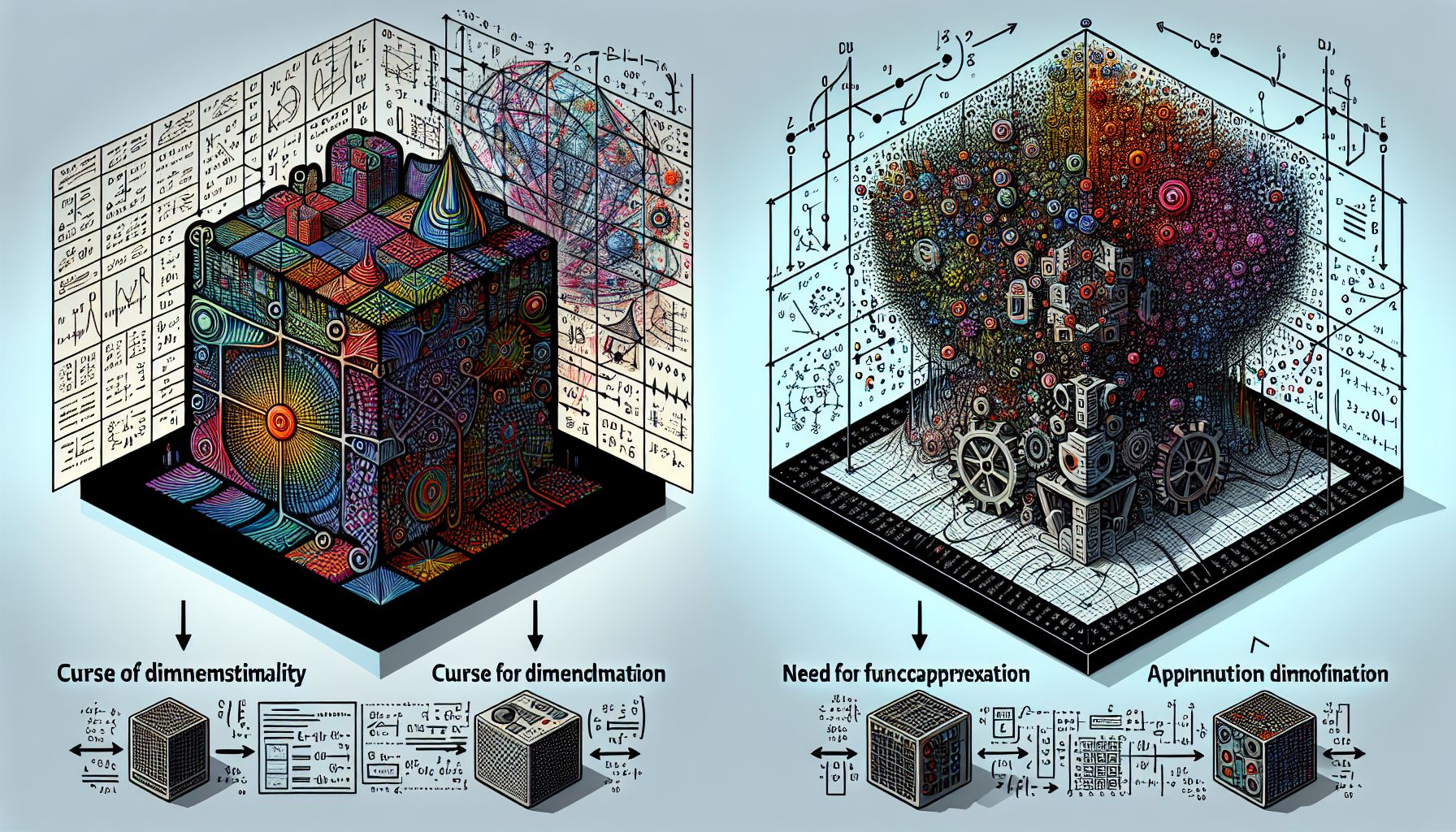📌 Let’s explore the topic in depth and see what insights we can uncover.
⚡ “Venture into data’s twilight zone where more isn’t always merrier; welcome to the realm of the curse of dimensionality! Decode the mystery that has data scientists turning to function approximation as their knight in shining armor.”
Hello, data enthusiasts! Today, we’re going to embark on a thrilling journey into the realm of high-dimensional data spaces and confront a menacing beast – the Curse of Dimensionality. 🧙♂️📊 Don’t worry! We’re not leaving you unarmed. We’ll arm you with the powerful weapon of function approximation to tame this beast. Before we dive in, let’s set the stage. The Curse of 🧠 Think of Dimensionality as a problem that arises when dealing with high-dimensional data — think datasets with a large number of features or variables. As the dimensionality increases, the volume of the space increases so fast that the available data become sparse, creating numerous challenges. Hold on tight as we explore the dark corners of the Curse of Dimensionality and discover the beacon of hope offered by Function Approximation. Ready? Let’s go!
🏰 The Kingdom of High-Dimensional Spaces

"Unraveling the Complex Web of High-Dimensional Data"
In the kingdom of data analysis, the term “dimension” refers to each attribute or feature that the data can possess. For instance, if we’re analyzing a dataset of fruits, we might have dimensions like weight, color, diameter, sugar content, and so on. Now, imagine a dataset with hundreds or even thousands of such dimensions. The complexity can quickly become overwhelming. As we increase the number of dimensions, we step into the realm of high-dimensional spaces. Here lurks the Curse of Dimensionality. The more dimensions we add, the more difficult it becomes to visualize the data and, more importantly, to extract meaningful information from it. 🔍 Interestingly, because as the dimensionality increases, the data points become increasingly sparse, making it difficult to capture the structure of the data. Here’s a fun metaphor to help you understand this: Imagine you’re in a vast desert, and you’re searching for a single grain of sand that’s different from all others. The larger the desert (or the higher the dimensionality), the tougher your search becomes. 🏜️
🧙♂️ The Curse of Dimensionality Unveiled
The Curse of 🧠 Think of Dimensionality as a term coined by Richard Bellman, a mathematician renowned for his work in decision-making processes. It describes the phenomenon where the computational complexity grows exponentially with the increase in dimensionality.
This curse leads to various problems:
Data Sparsity
As we’ve discussed, as the dimensionality increases, the data becomes sparse. This makes it challenging to find patterns or generalizations in the data.
Increased Computation Time
The computational requirements (both in terms of memory and processing time) for handling high-dimensional data can be staggering.
Overfitting
With high-dimensional data, it’s easy to create a model that fits the training data too closely, leading to poor performance on new, unseen data.
Loss of Intuition
In three dimensions or less, we can visualize data easily. Beyond that, our intuition often fails us, making it harder to interpret and understand the data.
🗡️ Function Approximation: A Weapon Against the Curse
So, how do we fight this curse? Enter Function Approximation.
Function approximation is a method used to estimate the function that generates the data points in a dataset. In other words, it’s trying to find a simpler, “good enough” function that can represent our complex, high-dimensional data. This function can then be used to predict outcomes for new data points.
There are two main types of function approximation:
Parametric Function Approximation
Here, we assume the function to be of a specific form. For example, in linear regression, we assume the function to be a linear combination of the input variables.
Non-parametric Function Approximation
In this case, we don’t make any assumptions about the form of the function. Methods like decision trees and support vector machines fall into this category. Function approximation methods can significantly reduce the dimensionality of our data, making it easier to handle and interpret. They essentially provide a simplified map of our vast desert, guiding us to that special grain of sand. 🗺️
🛡️ Tips to Combat the Curse of Dimensionality
Apart from function approximation, here are some additional strategies to confront the Curse of Dimensionality: * Feature Selection: This involves selecting a subset of the most relevant features (or dimensions) to use in model construction. * Dimensionality Reduction: Techniques like Principal Component Analysis (PCA) or t-distributed Stochastic Neighbor Embedding (t-SNE) can reduce the number of dimensions while retaining most of the information. * Data Augmentation: In some cases, generating synthetic data can help overcome the sparsity issue.
Remember, the goal is to simplify without losing the essence of the data.
🧭 Conclusion
The Curse of 🧠 Think of Dimensionality as a daunting challenge in the field of data analysis, making life difficult for data scientists and machine learning practitioners. It turns the usually exciting journey of exploring data into a perilous quest full of pitfalls and obstacles. However, with a proper understanding of this curse, and armed with powerful tools like Function Approximation and dimensionality reduction techniques, we can successfully navigate the maze of high-dimensional data spaces. Like any good adventure, the struggle and challenges only make the eventual success all the sweeter! 🏆 Remember that while the curse is powerful, it’s not invincible. With the right tools and strategies, you can tame the beast and turn the curse into a blessing, extracting valuable insights from even the most complex datasets. So, gear up, embrace the challenge, and turn your data exploration into an exciting quest of discovery!
🚀 Curious about the future? Stick around for more discoveries ahead!
🔗 Related Articles
- Logistic Regression for Classification, Sigmoid function and binary classification, Cost function for logistic regression, Implementing using Python/NumPy, Evaluation: Accuracy, Precision, Recall
- Bellman Equation for Value Function and Optimal Policy
- “Decoding Quantum Computing: Implications for Future Technology and Innovation”
